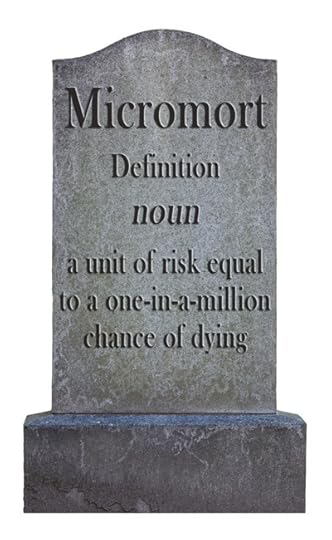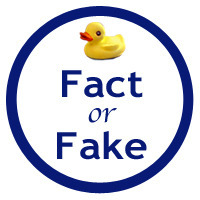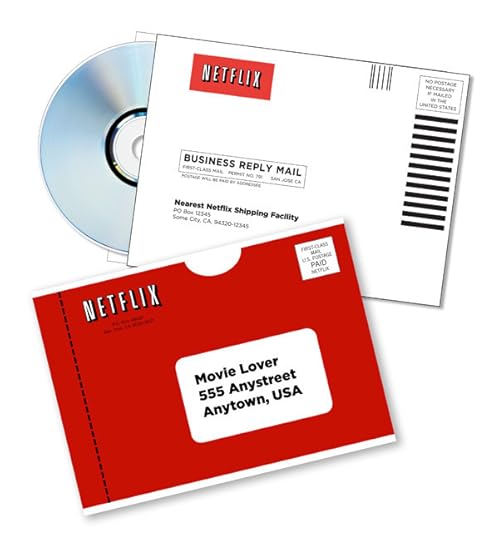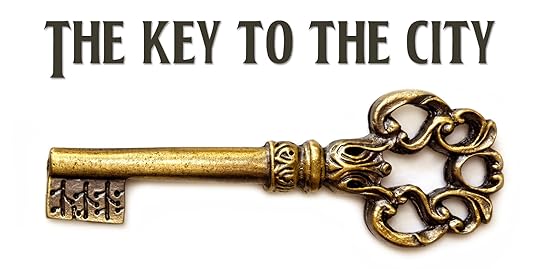Bathroom Readers' Institute's Blog, page 152
December 30, 2013
There’s A Small Chance This Article May Kill You
But it’s a very small chance. Behold the morbid mathematical weirdness of micromorts.
 In the middle of the 20th century, “risk assessment” became a field of interest for statisticians and actuaries alike. The idea was to create a mathematical model to determine exactly how risky an activity might be—riding a motorcycle or living in a house with a radon gas leak, for example.
In the middle of the 20th century, “risk assessment” became a field of interest for statisticians and actuaries alike. The idea was to create a mathematical model to determine exactly how risky an activity might be—riding a motorcycle or living in a house with a radon gas leak, for example.
But here’s the thing—everything carries with it some kind of risk. You could die by choking on a banana, or from spontaneous combustion. Both are extremely rare possibilities, but they’re possibilities nevertheless.
In 1970, those who had to assess risk for a living needed a term, and a mathematical figure, to measure those very, very small chances of death. Stanford University professor Ronald A. Howard invented the “micromort”—micro meaning “small” and mort coming from the Latin word for death. Simply put, a micromort is a tiny measure of potential deadliness—one micromort equals a one-in-a-million possibility of death. “A problem we continually face in describing risks is how to discuss small probabilities,” Howard wrote in 1989. “It appears that many people consider probabilities less than 1 in 100 to be too small to worry about.”
Basically, all activities increase your chance of death by a different amount of micromorts. Things that will increase your chance of death by 1 micromort include: drinking three glasses of wine, spending an hour in a coalmine, or eating 100 charcoal-cooked steaks. Those activities could lead to, respectively, cirrhosis, black lung, or cancer from eating ingesting a chemical called benzopyrene.
Some more micromort levels:
• Scuba diving adds about 5 micromorts.
• Hangliding is worth 8 micromorts. Skydiving is slightly less dangerous, at 7 micromorts.
• Using heroin? 30 micromorts…each time.
• Using the drug Ecstacy is worth about a half of a micromort, about the same risk as a day of skiing.
December 27, 2013
It’s Fact-or-Fake Friday!
 It’s Friday, and that means it’s time for your weekly fake-out. Here’s how it works: Two of the three following stories are true. One of them we made up. Can you guess which one is the fake? Pick your answer at the end of the article and see if you’re right.
It’s Friday, and that means it’s time for your weekly fake-out. Here’s how it works: Two of the three following stories are true. One of them we made up. Can you guess which one is the fake? Pick your answer at the end of the article and see if you’re right.
A.
A few weeks ago, some teenagers in Los Angeles found a mansion that was listed for sale…and used it to throw a raging party. The fete raged for 17 hours at the 9,000 square foot mansion, and caused an estimated $1 million worth of damage. (Value of house: $7 million.) The owners were away, but their stuff wasn’t. The teens, of which 16 were arrested, allegedly stole designer clothing, a suit of medieval armor, and a stuffed snow leopard reportedly worth $250,000.
B.
Zackary Aders is lucky he brought his serenading equipment. His goal was to walk through Muskogee County, Oklahoma, to see a woman, but somehow along the way he got lost and fell into a pond. So for 24 hours, he wandered around in freezing temperatures, and when his clothing began to freeze, he took it off. Rescuers eventually found him in his underwear attempting to take shelter in his guitar case.
C.
Timothy Sutton of Glendale, California, has used a prosthetic leg for nearly a decade, and he’s bought several feet to go along with it. He was recently looking for a new foot with better shock absorption for his hikes in Griffith Park, and turned to an eBay seller based in San Diego. When he tried to attach the foot, he discovered that he’d purchased a hollow shell with phony hardware attached. When the hardware was removed, he discovered inside the foot a half-pound of cocaine. “It was actually done pretty well,” Sutton told a reporter. “But I could tell there was something inside that thing.” California State Police are investigating.
Want more fakes? Check out Uncle John’s Fake Facts. (Really!)
December 26, 2013
It’s Time for ‘Time’ Person of the Year!
Once again, Uncle John came in at #2.
 • Entertainment Weekly publishes a list of the year’s top movie’s each December. Rolling Stone prints a list of the year’s best albums. The year-end superlatives started in 1927, with Time’s “Man of the Year.” It came about as an idea to fill space during a slow news week (as December often is), and also as a way for Time editors to make good on a mistake from earlier in the year. When Charles Lindbergh made his solo transatlantic flight…Time failed to put him on the cover. To make up for it, editors made Lindbergh Time’s “Man of the Year,” recognizing him as the year’s most dynamic newsmaker.
• Entertainment Weekly publishes a list of the year’s top movie’s each December. Rolling Stone prints a list of the year’s best albums. The year-end superlatives started in 1927, with Time’s “Man of the Year.” It came about as an idea to fill space during a slow news week (as December often is), and also as a way for Time editors to make good on a mistake from earlier in the year. When Charles Lindbergh made his solo transatlantic flight…Time failed to put him on the cover. To make up for it, editors made Lindbergh Time’s “Man of the Year,” recognizing him as the year’s most dynamic newsmaker.
• It’s not necessarily an honor to be named Person of the Year—Time says it simply singles out who made the biggest impact on the world, for better or for worse. Examples of this include past “winners” such as Adolf Hitler during World War II and Nikita Khrushchev at the height of the Cold War.
• Just a few weeks after the Sept. 11 attacks in 2001, Time named New York mayor Rudolph Giuliani its Person of the Year. It’s rumored that the magazine almost went with 9/11 mastermind Osama bin Laden, but went with Giuliani for a more positive spin, citing his representation of the American spirit and response to the tragedy.
• “Man of the Year” was officially changed to “Person of the Year” in 1999, although the first woman to receive the distinction was Philippines president Corazon Aquino in 1986.
• The 2013 Person of the Year is Pope Francis. He’s only the third pontiff to receive the distinction. He follows Pope John Paul II in 1994 and Pope John XXIII in 1962.
• Since 1927, every American president has been given the honor at least once…except for Herbert Hoover and Gerald Ford.
• Dwight Eisenhower was named Man of the Year as a World War II general in 1944, and again as president in 1959.
Boxing Day 101
In the United States, the day after Christmas is simply the day after Christmas. In the UK, however, it is Boxing Day: a holiday in its own right.
 Tip Till You Flip Boxing Day is December 26. Traditionally this is when all the haves distributed gifts and money to the have-nots—the poor or people who provided services throughout the year.
Tip Till You Flip Boxing Day is December 26. Traditionally this is when all the haves distributed gifts and money to the have-nots—the poor or people who provided services throughout the year.
Street sweepers, waiters, lamplighters, milkmen, newsboys— you name it. Think of it as a Victorian orgy of tipping— though it actually goes back much further than Victoria’s reign. A 16th-century abbess, for instance, wrote about giving money to her kitchen clerk, servants, the gardener, and the “Baily of the Husbandry,” whatever that was.
Not everyone was crazy about the Boxing Day tipping frenzy. Jonathan Swift—who wrote Gulliver’s Travels—was quite put out when the Boxing Day tips to his coffeehouse attendants doubled. He had to pay, or else he’d look like a cheapskate in front of his friends. That was nearly 200 years ago—something to think about next time you drop some change at Starbucks.
Why Call It Boxing Day ?
There are innumerable theories about where the name Boxing Day comes from, but no evidence to back up any of them.
Here’s a list of the most commonly encountered origin stories— feel free to insert maybe at the beginning of every sentence:
• Churches have locked boxes with slots in them to collect money for the poor. Called alms boxes, they may have been opened on December 26 and the contents distributed to the needy on that day.
• Church alms boxes may date back to imperial Rome. The Romans had a holiday called Paganalia to celebrate the crops sown in winter. The holiday came to England with the Roman conquerors. As part of the festivities, towns set up altars, and everyone piled coins for the poor on them.
• Apprentices carried earthenware boxes around to collect pay owed to their masters. They used the same type of box at Christmas to ask for tips for their good service.
• In 1703, one John Dunton speculated that the term Boxing Day came from the days when ships carried locked boxes holding offerings to the ship’s patron saint. Before the ship sailed, everyone contributed a few pence, and no one could touch the box until the ship returned home safely.
The Weird Stuff As with Christmas, some odd customs developed around the day. Horses were exercised and then bled on December 26, to keep them healthy throughout the year. Until the sport was banned in England in 2005, fox hunting meets took place on Boxing Day. These traditions may be connected to the fact that December 26 is also the feast day of Saint Stephen, who is the patron saint of horses—though no one knows why.
(Stephen was the first Christian martyr back in the 1st century and had nothing whatsoever to do with horses.)
Boxing Day was traditionally a big night for theaters, since all the workers had some extra cash in their pockets.
Pantomimes were introduced that night, and to this day mummers’ performances occur all over England on Boxing Day weekend.
In some counties, a Saint Stephen’s breakfast of beef and beer is put out for all takers. In Ireland, roving boys will carry around a dead wren, asking for money to bury it.
Why hasn’t the rest of the world adopted this charming holiday? After all, pouring out money for gifts and tips on the day after Christmas, bleeding horses, watching mimes, and carrying dead birds around sounds pretty appealing. The rest of us just don’t know what we’re missing!
Originally published in Uncle John’s Bathroom Reader Christmas Collection.
December 24, 2013
Impossible Questions: The Name Game – Answers Revealed!
1. For what works are the 19th century authors A.M. Barnard, Currer Bell, and Ellis Bell best known?
They’re all pseudonyms used by major female authors of the time. Publishers in 19th century England and the U.S. were reluctant to publish anything written by women, so women used phony names to submit their work. It wasn’t until the 1970s that a Harvard historian named Leona Rostenberg discovered letters from Alcott to publishers dating to 1865 revealing that she published in periodicals under “A.M. Barnard.” As for the Bells, those are pseudonyms for Charlotte Bronte and Emily Bronte. Their first novels, the classics Jane Eyre and Wuthering Heights, respectively, were both first published in 1847 under fake male authorship.
2. Why are writers Nathan E. Douglas, Ian McLellan Hunter, and Robert Rich most famous?
They’re pseudonyms that won Academy Awards. The Hollywood “blacklist.” prevented suspected or accused Communist sympathizers from working in film in the 1950s. Or at least it prevented them from getting credit for their work under their real names. For example, the 1958 film The Defiant Ones was written by Nedrick Young and Harold Jacob Smith. The blacklisted Young couldn’t take credit, so he used the name “Nathan E. Douglas.” Director Stanley Kramer had a little fun with it—he gave Young and Smith bit parts as truck drivers in the first few minutes of the film. The writing credit for “Douglas” not-so-accidentally appears on screen at the same moment as Young and Smith. The other two names were both used by blacklisted writer Dalton Trumbo. “Hunter” won the 1953 best story Oscar for Roman Holiday. “Rich” won in 1956 for The Brave One.
3. What do Roderick Jaynes, Donald Kaufman, and P.H. Vazak have in common?
They’ve all been nominated for Academy Awards…and none of them really exist. Joel and Ethan Coen write, direct, and produce their own movies, and their edit them, too. They credit the fictitious Jaynes with the task, and “he” has been nominated for his work on Fargo and No Country For Old Men. Donald Kaufman is the imaginary twin brother of screenwriter Charlie Kaufman. The real Kaufman wrote the 2002 film Adaptation, about a struggling screenwriter named Charlie Kaufman, and his bizarre twin brother, Donald. There is no Donald in real life, and crediting Donald was a joke from Kaufman. Both still were nominated. P.H. Vazak is the name of screenwriter Robert Towne’s dog. The pooch got credit—and a writing nomination—for the 1985 movie Greystoke. Towne didn’t like what the studio did to his script, so he replaced his own name with Vazak’s.
December 23, 2013
Impossible Questions: The Name Game
 Think you know everything there is to know? See if you can answer these brain-benders…and come back tomorrow to see if you’re right.
Think you know everything there is to know? See if you can answer these brain-benders…and come back tomorrow to see if you’re right.
1. For what works are the 19th century authors A.M. Barnard, Currer Bell, and Ellis Bell best known?
2. Why are writers Nathan E. Douglas, Ian McLellan Hunter, and Robert Rich most famous?
3. What do Roderick Jaynes, Donald Kaufman, and P.H. Vazak have in common?
Want more impossible questions? Check out Uncle John’s Impossible Questions.
How Netflix Works
The long, strange journey of a Netflix DVD.
 When you place a disc into the Netflix-provided return envelope, it’s addressed to a simple post office box number. So does Netflix have a gigantic P.O. box at every post office in North America? Nope—that box number written on the envelope doesn’t really exist.
When you place a disc into the Netflix-provided return envelope, it’s addressed to a simple post office box number. So does Netflix have a gigantic P.O. box at every post office in North America? Nope—that box number written on the envelope doesn’t really exist.
The massive volume of DVDs being returned to Netflix would not fit in even the largest box offered by local post offices. Instead, the P.O. box number that Netflix rents at your post office is actually a huge sorting bin. (In the mail order industry, the term for this is “phantom post office box.”) Postal employees toss any returning Netflix movies into that bin throughout the working day.
Next, that full Netflix bin has to get to the closest of Netflix’s 58 distribution centers. That’s where the DVDs originate and to where they are returned. Generally, they’re anonymous, unmarked warehouses. That distribution center sends out to its service area each night—in the middle of the night—anonymous, unmarked white trucks to collect those bins from its area’s post offices. The trucks are due back at the distribution center before dawn, where employees tear open all those DVD envelopes, scan them as returned, and go about sending out the next item on your Netflix queue via the mail.
After more than a decade in existence, Netflix has the process down pat. That, and the phantom P.O. box system means that you don’t even have to use those pre-addressed red mailers. It certainly speeds things up, but if you ever lose your Netflix envelope, you can put the disc in a regular envelope, add a stamp, and write just “Netflix” on it, and it will get back to the distribution center. No address required—since you wouldn’t know what to write down.
December 20, 2013
The Key to the City
It’s a great honor to be given the “key to the city.” What powers does the honor grant? None really. But it’s a nice honor. Here are some famous people who have been given a giant novelty key.
 • In 2010, reality TV’s Kardashian family (and Bruce Jenner) was granted the key to Beverly Hills.
• In 2010, reality TV’s Kardashian family (and Bruce Jenner) was granted the key to Beverly Hills.
• The Jackson 5 were born and raised in Gary, Indiana. When they became hugely popular, all five were given the key to the city.
• What’s the hard rockingest city in the United States? West Valley City, Utah, of course! At least that’s where Axl Rose of Guns N’ Roses has a key to a city.
• In 1990, Cher performed at a Formula One car race in Adelaide, Australia, and was given the key to the city. In 2012, her management sold the actual key on eBay for $96,000.
• Newspaper advice columnist Ann Landers once received the key to the city of Albion, Michigan. (But not her sister, “Dear Abby,” also known as Abigail Van Buren.)
• Spokane, Washington, gave a key to President Harry Truman while he was campaigning there for re-election in 1948. (Truman carried Washington in the election.)
• In both 2008 and 2012, the players and coaches of the NFL’s New York Giants were given keys to the city of New York after winning the Super Bowl. (Interestingly, the Giants don’t play their home games in New York City—their stadium (and the team’s offices) are in New Jersey.
• After making a donation to a large Detroit church there, Iraq dictator Saddam Hussein was given the key to Detroit.
• On the other end of the spectrum, Detroit annually presents Santa Claus with the key to the city, at the end of its yearly Thanksgiving parade.
• In 2009, Buffalo, New York gave NFL star—and Buffalo Bill—Terrell Owens the key to its city. But on a few conditions: He had to catch 10 touchdown passes and get the team to the playoffs. He caught five, the Bills missed the playoffs, and Owens was traded. (No word on if he got to keep the key or not.)
Fact or Fake Friday
 It’s Friday, so that means it’s time for your weekly fake-out. Here’s how it works: Two of the three following stories are true. And one of them we made up. Can you guess which one is the fake? Pick your answer at the end of the article and see if you’re right.
It’s Friday, so that means it’s time for your weekly fake-out. Here’s how it works: Two of the three following stories are true. And one of them we made up. Can you guess which one is the fake? Pick your answer at the end of the article and see if you’re right.
A.
And you thought that HealthCare.gov was a fiasco. The New York Times reported last week that The Federal Register, a print and online journal that documents the federal government, from proclamations to executive orders and more, will no longer accept digital versions of documents via popular methods such as flash drive or SD card. No, they 3.5-inch plastic floppy discs, which have all but disappeared to since 2000. Most computers don’t even have them anymore. Discs must be regularly delivered to The Federal Registrar by courier.
B.
A man flying from Louisiana to California fell asleep on the first leg of the trip. He later woke up in a cold, dark, locked plane by himself. The United Express jet’s other passengers and staff all neglected to wake Tom Wagner, who, after realizing that he was not, in fact, dreaming, called his girlfriend in a panic. “She thought I was crazy. I said, ‘Debbie I’m locked on the plane,’” he told reporters. “I said, ‘I’m telling you the truth. You better go somewhere and get me off this plane.” Once she figured out that he wasn’t joking, Debbie made calls to have him Wagner rescued. Workers arrived about a half hour later, and while they didn’t refund his flight, they did offer to put him up in a hotel and gave him a $250 voucher for his next flight on United Express.
C.
Gordon Rodriguez was fed up with his bank teller job at First National Bank of Omaha. After landing a new job at a local credit union, he went out to celebrate with some friends. After a few rounds, Gordon left his friends at the bar, saying he was going to “get even” with his soon-to-be-former boss, Jim Maloney. At 2:40 a.m., Maloney called 911 to report that a man with no pants on had fallen off of his roof and was unconscious and bleeding on the front steps. It wasn’t until paramedics arrived that Maloney recognized Rodriguez. Rodriguez suffered a broken arm, a fractured rib, and a concussion. No word on whether the job at the credit union is still available (but the old one is probably off the table).
Want more fakes? Check out Uncle John’s Fake Facts. (Really!)
December 19, 2013
Famous TV Sign-Offs
To mark the release of Anchorman 2, here is a look back at famous anchormen and their signature “sign-off.” You stay classy, BRI fans.
 “Good night, and good luck.” Possibly the most famous sign-off in TV history, this phrase was coined by 1950s CBS News personality Edward R. Murrow (Person to Person, See It Now). He had gotten his start on CBS Radio during World War II, broadcasting from the rooftops of London buildings during the German blitz. With the line, Murrow was earnestly reaching out to the audience in an attempt to provide comfort. He kept the line after the war.
“Good night, and good luck.” Possibly the most famous sign-off in TV history, this phrase was coined by 1950s CBS News personality Edward R. Murrow (Person to Person, See It Now). He had gotten his start on CBS Radio during World War II, broadcasting from the rooftops of London buildings during the German blitz. With the line, Murrow was earnestly reaching out to the audience in an attempt to provide comfort. He kept the line after the war.
“See you on the radio.” CBS Sunday Morning anchor Charles Osgood got his start in radio, and for a while he juggled careers in both radio and TV news. His parting words on his TV appearances became “See you on the radio,” and he kept the sign-off even after he had completely left radio.
“Good night, Chet.” “Good night, David.” When Chet Huntley and David Brinkley hosted The Huntley-Brinkley Report on NBC from 1956 to 1970, they weren’t even in the same room, let alone the same city. Brinkley broadcast from Washington, D.C., and Huntley from New York. Rarely did they actually speak to each other during the news broadcast, but they always ended the show with this tagline.
“And so it goes.” Lloyd Dobyns coined the phrase (based on the line “So it goes!” from Kurt Vonnegut’s Slaughterhouse-Five), but Linda Ellerbee popularized it when she succeeded Dobyns as the host of several NBC late-night news shows in the late 1970s and early ’80s. The line was later used by fictional reporter Murphy Brown (Candice Bergen) on Murphy Brown (1988–98). Ellerbee guest-starred on an episode and argued with Brown over who originated the phrase.
“Good night, and good news.” Okay, it’s not a real news anchor’s sign-off. It was used by Ted Baxter, the fictional Minneapolis anchorman played by Ted Knight on The Mary Tyler Moore Show (1970–77). It’s a parody of and homage to Murrow.
“And that’s the way it is.” CBS Evening News anchor Walter Cronkite never intended for this sign-off to become his signature line repeated nightly for decades. When he began anchoring the news in 1962, he’d planned to end each broadcast with a human interest story, followed by a brief off-the-cuff commentary or final thought. But producers told him there wouldn’t be enough time to do all that, so he quickly came up with “And that’s the way it is.” Years later, he still thought it sounded “too authoritative.”
“And that’s a part of our world.” Dan Rather took over for Cronkite in 1981, and by 1986 he was itching to create a tagline as memorable as Cronkite’s. Without telling producers, he started using one he’d come up with. At the end of a broadcast in September 1986, he said just one word: “Courage.” Two days later, following a story about Mexico, Rather said “Corajé” (Spanish for “courage”). It didn’t work out; shortly thereafter, Rather switched to the modest “And that’s a part of our world.”
“We’re in touch, so you be in touch.” Hugh Downs, and later Barbara Walters, uttered this line at the end of ABC’s newsmagazine 20/20. Although Downs doesn’t recall exactly why he started using the phrase, he has said it was probably a subtle request for viewer mail.
“If it’s Sunday, it’s Meet the Press.” The late Tim Russert’s closing phrase as host of the Sunday morning political discussion show Meet the Press sounded more like an introduction…for a show that had just ended. When interim host Tom Brokaw stepped in to host after Russert died in 2009, he kept Russert’s line as a tribute.
Originally published in Uncle John’s Bathroom Reader Tunes into TV.



